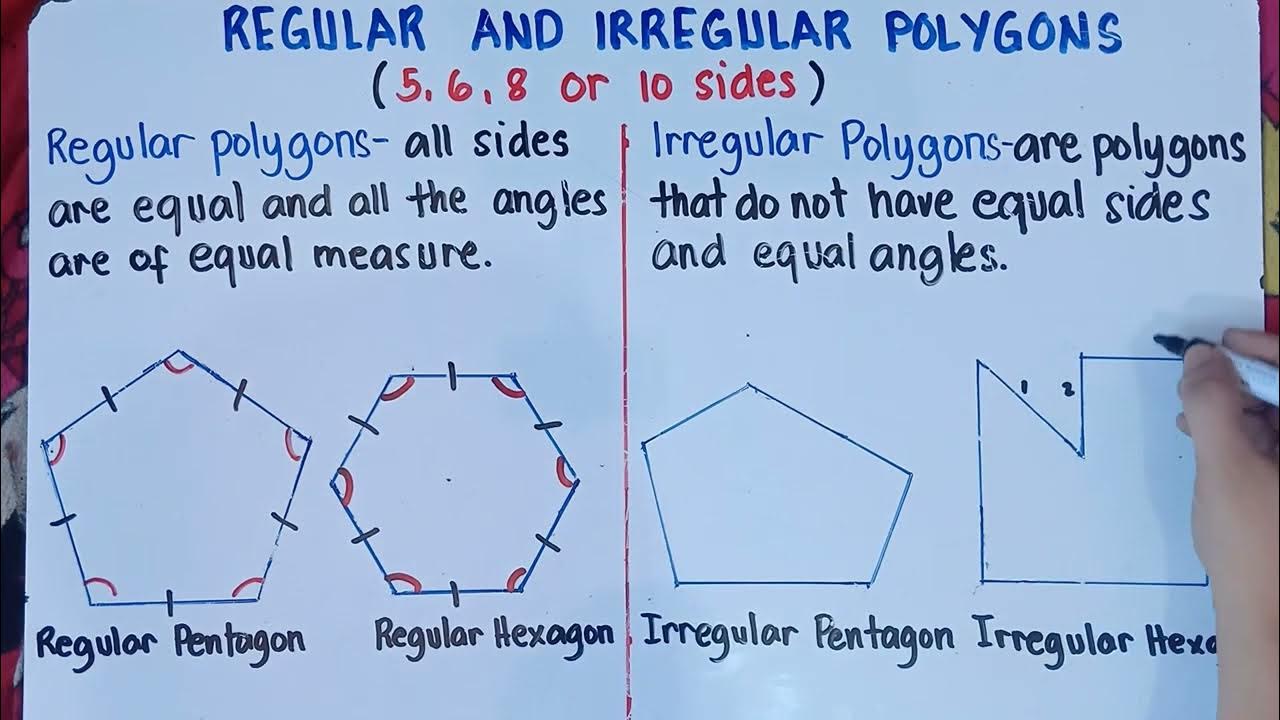Naming a Polygon and Its Parts | Matatag Curriculum | Grade 7 | Explain in Detailed |
Summary
TLDRIn this educational video, Teacher MJ introduces the concept of polygons, focusing on naming and identifying their parts. The lesson defines a polygon as a closed figure with line segments in a two-dimensional plane. It distinguishes between a triangle, with three sides, and a quadrilateral, with four sides. The video explains the components of a polygon, including vertices where sides meet, sides as line segments, and angles formed by these sides. Teacher MJ emphasizes the importance of using consecutive vertices when naming polygons, providing multiple examples and variations for both triangles and quadrilaterals, ensuring a comprehensive understanding of the topic.
Takeaways
- 📚 A polygon is a closed figure made up of line segments in a two-dimensional plane.
- 🔢 A polygon with three sides is called a triangle, and one with four sides is called a quadrilateral.
- 📐 The parts of a polygon include vertices (points where sides meet), sides (line segments), and angles.
- 📌 The vertex is the point where two sides or line segments of a polygon meet, forming a corner.
- 🌐 Sides of a polygon are the line segments that connect the vertices, and they can be named in any order but are usually listed alphabetically.
- 🔄 Angles in a polygon are formed by two adjacent sides and can be named based on the vertices that form them, ensuring the vertex names are in a clockwise or counterclockwise order.
- 📝 When naming a polygon, the vertices must be listed consecutively, and the names must reflect this order.
- 🔄 For a triangle, there are six possible namings based on the order of the vertices, while a quadrilateral has eight possible namings.
- 📐 In a quadrilateral, the sides are named as pairs of vertices they connect, such as AB, BC, CD, and DA, and can be read in either direction.
- 📝 The script emphasizes the importance of consecutive vertex naming for polygons and provides examples of correct and incorrect naming conventions.
- 🤓 The lesson encourages students to ask questions and engage with the material, promoting an interactive learning environment.
Q & A
What is a polygon?
-A polygon is a closed figure made up of line segments in a two-dimensional plane.
What is the term for a polygon with three sides?
-A polygon with three sides is called a triangle.
What is the term for a polygon with four sides?
-A polygon with four sides is called a quadrilateral.
What is a vertex in the context of a polygon?
-A vertex is a point on a polygon where two line segments meet.
How many vertices does a triangle have?
-A triangle has three vertices.
How many sides does a quadrilateral have?
-A quadrilateral has four sides.
What is the term used for the line segments that form the perimeter of a polygon?
-The line segments that form the perimeter of a polygon are called sides.
How are the sides of a polygon named?
-The sides of a polygon are named by the vertices they connect, such as side AB or line segment AB.
What is an angle in a polygon?
-An angle in a polygon is the figure formed by two sides or line segments meeting at a vertex.
How can you name a triangle using its vertices?
-A triangle can be named using any three consecutive vertices, such as triangle ABC.
What is the rule for naming a quadrilateral using its vertices?
-A quadrilateral should be named using consecutive vertices, such as quadrilateral ABCD.
Can the vertices of a polygon be named in any order?
-No, when naming a polygon, the vertices must be listed in a consecutive order.
What is the difference between a line segment and a side in a polygon?
-A line segment is a part of a polygon that connects two vertices, while a side refers to the entire length between two vertices, forming part of the polygon's perimeter.
How many names can a triangle have based on its vertices?
-A triangle can have six different names based on its vertices, such as triangle ABC, triangle BCA, triangle CAB, triangle BAC, triangle ACB, and triangle CBA.
How many names can a quadrilateral have based on its vertices?
-A quadrilateral can have eight different names based on its vertices, such as quadrilateral ABCD, quadrilateral ABDC, quadrilateral ACBD, quadrilateral ACDB, quadrilateral BACD, quadrilateral BADC, quadrilateral BCDA, and quadrilateral BDAC.
Outlines

Dieser Bereich ist nur für Premium-Benutzer verfügbar. Bitte führen Sie ein Upgrade durch, um auf diesen Abschnitt zuzugreifen.
Upgrade durchführenMindmap

Dieser Bereich ist nur für Premium-Benutzer verfügbar. Bitte führen Sie ein Upgrade durch, um auf diesen Abschnitt zuzugreifen.
Upgrade durchführenKeywords

Dieser Bereich ist nur für Premium-Benutzer verfügbar. Bitte führen Sie ein Upgrade durch, um auf diesen Abschnitt zuzugreifen.
Upgrade durchführenHighlights

Dieser Bereich ist nur für Premium-Benutzer verfügbar. Bitte führen Sie ein Upgrade durch, um auf diesen Abschnitt zuzugreifen.
Upgrade durchführenTranscripts

Dieser Bereich ist nur für Premium-Benutzer verfügbar. Bitte führen Sie ein Upgrade durch, um auf diesen Abschnitt zuzugreifen.
Upgrade durchführenWeitere ähnliche Videos ansehen

Parts of Speech(Verb, Noun and Pronoun)

Regular and Irregular Polygons | Grade 7 | Matatag Curriculum | Quarter 1 |

Multiplication of Binomials using FOIL method and Vertical Form | Grade 8 | Q1 | Revised K-12 |

Mengenal Bangun Datar Kelas 2 SD Kurikulum Merdeka

Grade 8 Science Q1 Ep11: Electrical Circuit

Naming hydrocarbon ( alkane) Nomenclature ( IUpAC) (Tagalog / English)
5.0 / 5 (0 votes)
